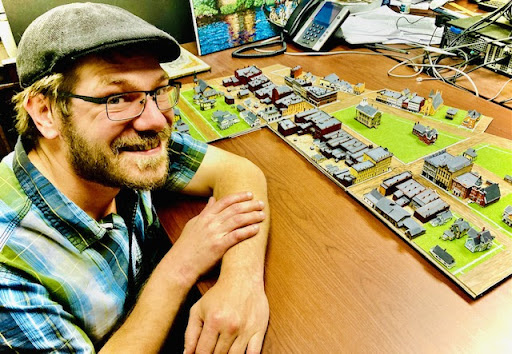
Collegian | Sean Callaghan
Assistant Professor of Classics Joshua Fincher has been toiling away at recreating a miniature model of 1890 Hillsdale.
“A model is what allows people to see what all was there and see it all in conjunction,” he said.
The story of the miniature display began with Fincher looking for a hobby in December of 2020 during the COVID-19 pandemic. He said he wanted something that was distinct from teaching classics, but also included his love for 19th-century architecture.
“It was something that sounded fun and was a way for me to learn about Hillsdale,” he said.
Fincher also said he wanted the project to help educate and inform the people about the architectural history of the town.
“The model provides the ability to present Hillsdale in a way that people can interact with when much of it is gone,” he said.
According to Joanne Miller, a member of the Hillsdale Historical Society, the model also created a great amount of attention during its exhibition at the county fair.
“As far as the interest the village elicited at the fair, I can say that it was a wonderful draw,” Miller said in an email. “In three dimensions, it brought to life many of the pictures people had seen of old Hillsdale. There were many visitors who looked into the display case as they passed by and then stopped dead and spent quite a bit of time finding specific buildings. We can hardly wait to see how much more he has added next summer.”
Fincher contrasted the difference in which the model presents the town’s architectural history compared to photographs.
“Historical information about architecture is conveyed through photographs and photographs are usually limited in what they portray,” he said. “You might see one building or two buildings. It’s hard for people to get a sense of how all the buildings on a block interacted together.”
Fincher said he wants the model to give a full view of the town, rather than a 2D view as seen in most photographs. Only a handful of the original buildings in 1890 remain today, he said.
Fincher gave the example of present-day H. J. Gelzer’s Furniture store, which was originally an opera house with two more stories before their eventual demolition.
“Small buildings are just as important as the main buildings in thinking how a town or architectural ensemble works together,” Fincher said.
The project also provides a different type of challenge for Fincher who spends his weekends working on the model.
“It’s a different way of thinking. It’s still logical, it’s still complex, but it’s fun. You have to solve and use geometry,” he said. “You have to think well in advance of how you’re going to construct a certain building.”
In addition to Fincher’s desire to educate, he also wishes the model to be a source of inspiration to locals and students, he said.
“I really hope that people who have these buildings or who live here will hopefully take pride in them, fix them up, and try to restore the decorative elements that have been lost,” he said.
Mitchell Research Center volunteer Carol Lackey said she also enjoyed Fincher’s work, given her extensive knowledge of the town’s architecture.
“His attention to detail, together with his enthusiasm is indeed catching,” she said in an email. “His ability to construct on such a small, yet accurate scale is fascinating!”
Lackey also said she loves the way in which the project provides an opportunity for both the college and the town to work alongside each other.
“I believe this project helps bring the college and city closer together!” Lackey said.

